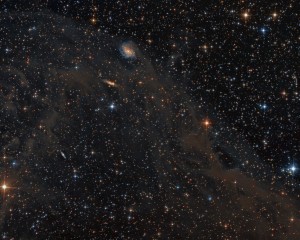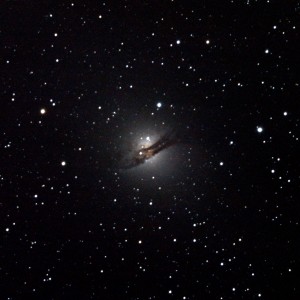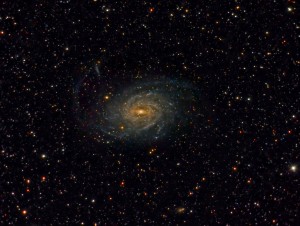August 2015: Dust and Galaxies by Brett du Preez
This distant galaxy appears to be linked by a stream of dust to a neighbouring galaxy and several bright stars, but it is all an illusion. Although the two galaxies are related, the dust lane and stars are all part of our own Milky Way galaxy. The galactic pair are actually many millions of light years in the background, and it is only coincidence that causes them to appear to line up.
July 2015: NGC 3372 by Neil Viljoen
The Great Nebula in Carina was discovered in 1751 by Nicolas Louis de Lacaille, during his time in Cape Town. It is a vast bright nebula, visible to the naked eye and covering an area in the sky several times larger than the full Moon.
There are a number of interesting objects within the Carina Nebula, including the bright hyper-giant star Eta Carina, the dark Keyhole nebula, the Homunculus nebula, the “Mystic Mountain” dust-gas pillar, and several open clusters of stars.
It is between 6500 and 10000 light years away, and shine with a surface magnitude of 1, making it easily visible to the naked eye.
June 2015: NGC 5128 - the 5th brightest galaxy in the sky by Allen Versfeld
Centaurus A is one of the gems of the southern skies, and one of the brightest galaxies visible from Earth. It is an active galaxy located about 12 million light yers from Earth. The product of a merger between two galaxies, Centaurus A has an unusual elliptical shape with an enormous meandering dust lane obscuring the centre. When viewed in radio wavelengths, it shines extremely brightly and appears larger than the full moon, thanks to the relativistic jets being ejected by the supermassive black hole at the galaxy’s core.
Centaurus A was discovered in 1826 by James Dunlop, from his home in New South Wales, Australia.
May 2015: NGC 6744 - The Pavo Spiral by Leslie Rose
The Pavo Spiral, NGC 6744, is a spiral galaxy some 30 million light years away in the constellation Pavo (the Peacock). It is notable for being most similar to our own Milky Way of any nearby galaxy. It has a barred spiral structure with an elongated core, flocculent spiral arms, and at least one satellite dwarf galaxy.
April 2015: The Great Nebula in Carina by Zander Horn
This image of NGC 3372 in Carina was taken by Xander Horn in February 2015, at the Southern Star Party in the Western Cape. This nebula is brighter than the great nebula in Orion, and about four times bigger. It contains several open star clusters, and a hypergiant star named Eta Carina (shared by the nebula as its more common name). It is an active star forming region, and is one of the gems of the southern skies.
March 2015: M20 - the Trifid Nebula by Andre Potgieter
This image of the Trifid Nebula was taken by Andre Potgieter from a backyard in Uitenhage. It has a cumulative exposure length of 9.3 hours and was captured with an inexpensive DSLR camera.
The Trifid, catalogued as M20 and NGC 6514, is a region of molecular hydrogen in the constellation Sagittarius. It’s distance has not been well established, but it lies somewhere between 2200 and 7600 light years away. This particular cloud of dust and gas can be seen from Earth as both an emission nebula and a reflection nebula. A young cluster of stars in the pink part of the region have just been born, and shine hotly in blue and ultraviolet light, which energises the surrounding gas. The gas glows with a characteristic red colour, common to all such regions. But other parts of the cloud are too far from the new stars to be energised in this way, and merely reflect the starlight back towards us. The size of the molecules and dust particles reflect blue light more than red, which gives reflection nebulae their characteristic blue colour.
The nebula gets its name from the arrangement of dark lanes snaking through the region. Through the eyepiece, three major lanes branch out from each other in the centre, hence “Trifid”.






